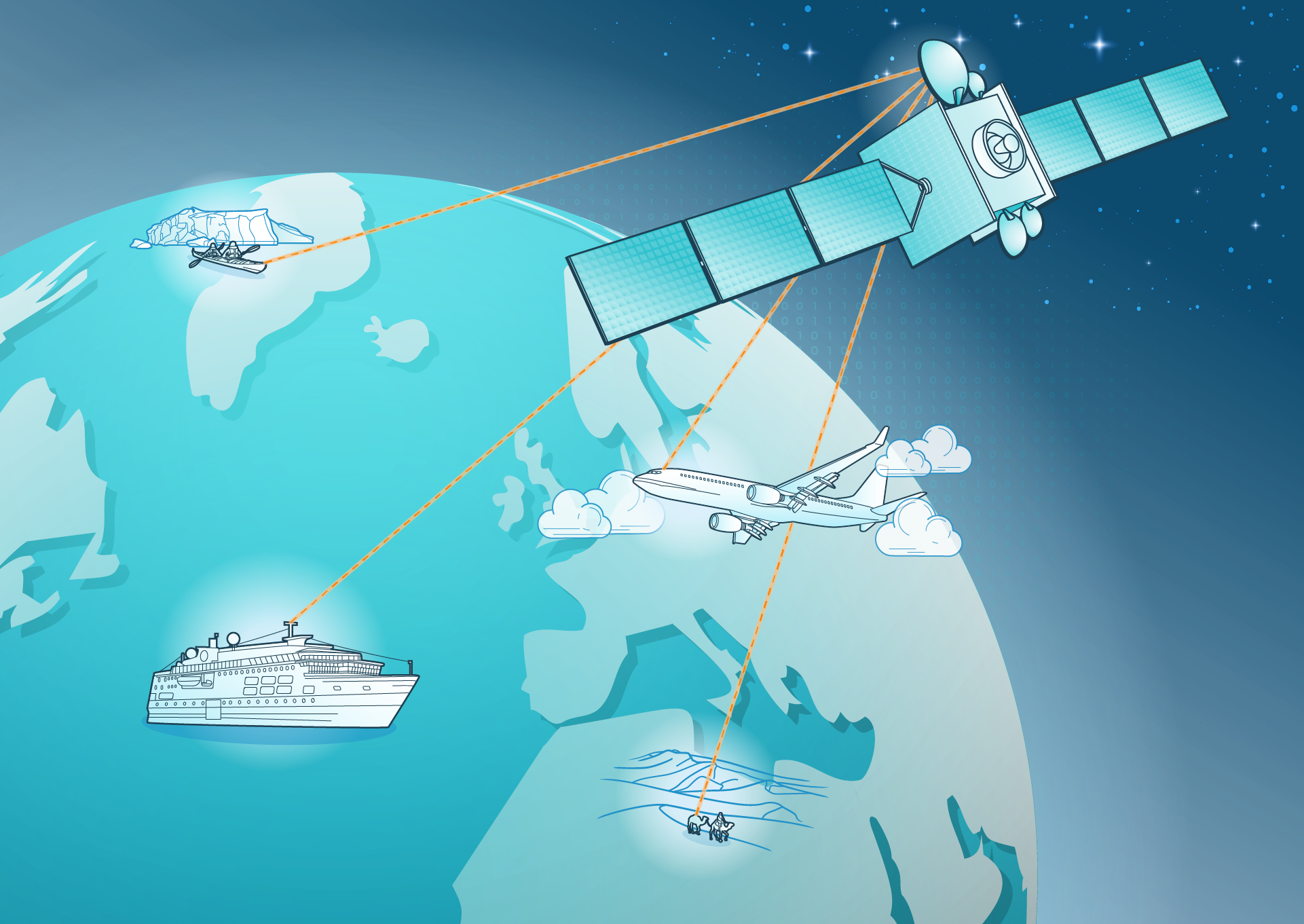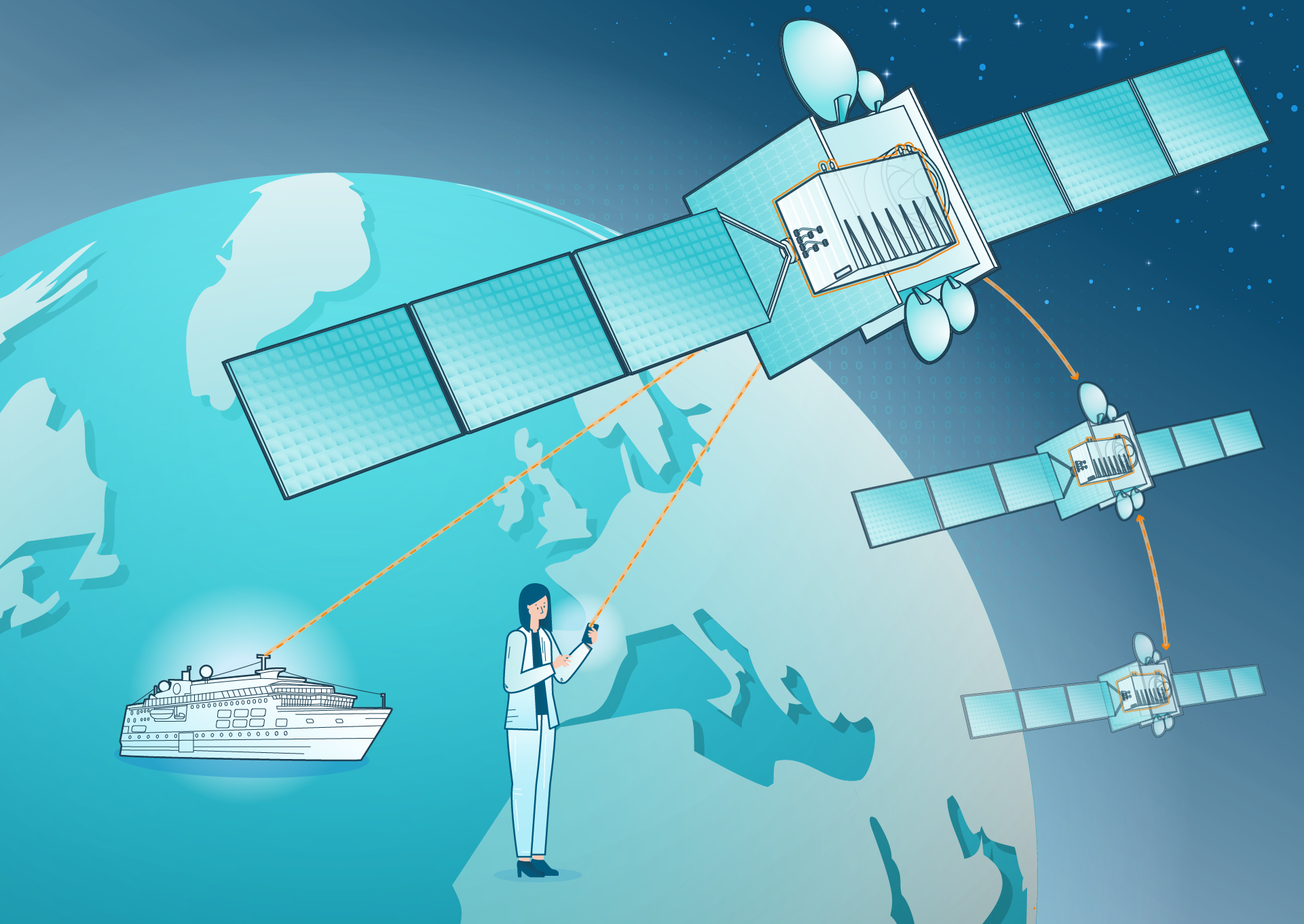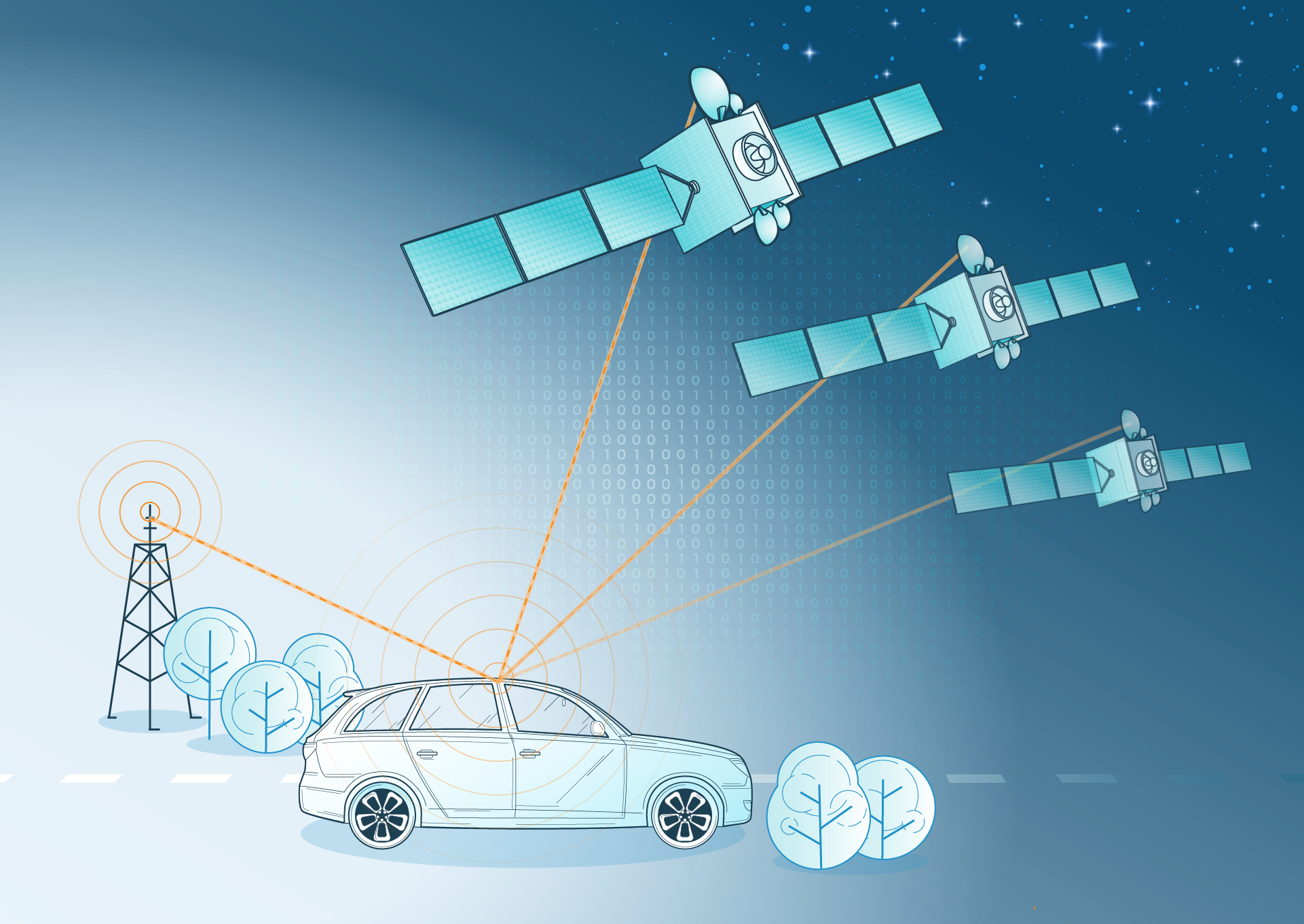Satellites are the shooting stars in the 5G universe. This is because with their extensive geographic coverage, they have the potential to bring 5G – and one day 6G – to every corner of the planet and thus pave the way for global connectivity. At Fraunhofer IIS, we’re working on enhanced satellite coverage, cellular base stations on satellites, and handover procedures that in the future will enable our smartphones to communicate seamlessly via satellite.
On course for success: satellites in the mobile network
Juni 14, 2024 | Release 19 of the 5G Standard
Integrating satellites into mobile networks creates a hybrid network in which the mobile communications infrastructure on the ground works fluently with satellites in space. This provides devices with a seamless and universally available connection via 5G and eventually 6G. Such a fully integrated network is entirely without limits and thus opens up novel communication possibilities. It also puts satellite connectivity for smartphones within reach, with users ideally unable to tell whether they are connected via satellite or a base station on the ground.
Satellites as boosters for global applications
Establishing seamless monitoring of the location and condition of goods and transports even as they cross oceans on ships and aircraft will be of particular benefit to the logistics and transportation industries. What’s more, this added mobility opens up new development opportunities for the automotive industry. This is because vehicles are increasingly transforming into smart communication platforms that rely on seamless connectivity to offer their users more and more services. Examples of why this kind of connectivity is needed include reporting breakdowns and accidents as well as transmitting software updates and traffic- and safety-related information to the vehicle even in the most remote regions. In the future, it will be easier to organize help in such situations and in the case of disasters: should terrestrial base stations fail, overload, or simply not be present, communications can be seamlessly rerouted via satellite. Moreover, emergency services won’t need to carry any additional communication equipment – everything happens via the mobile network.
The convergence of terrestrial and satellite-based networks is being driven forward by 5G standardization as part of the 3rd Generation Partnership Project (3GPP). Back in 2017, 3GPP began initial studies on how to integrate satellites into mobile networks under the heading “Non-Terrestrial Networks (NTNs).” The first basic functions that make a 5G connection via satellite possible have now been specified. With Release 19 of the 5G standard, which has been in development since the beginning of 2024, NTNs are now set to shift into the next gear. Three things are essential for this: enhanced satellite coverage, cellular base stations on satellites, and seamless handover procedures that allow devices to switch from one base station to the next without interruption.
Perfect reception everywhere, thanks to enhanced coverage
Driving global connectivity forward will require satellites to close the remaining gaps in 5G provision. However, the area a satellite can supply data to is not as fixed as one might think. There are a number of levers for adjusting coverage to meet demand around the world, or to make communication via satellite more reliable. Release 19 is expected to yield new solutions here, with a variety of approaches currently under consideration for designing the perfect data transmission from satellite to ground. To simulate how improvements to the transmission techniques affect a satellite’s potential coverage area as well as the reliability of the connection, we use the system-level simulator for NTNs that we developed right here at Fraunhofer IIS. This is an entirely software-based test environment capable of simulating and testing the complex processes relating to non-terrestrial networks. Our research activities include investigating how to use transmission redundancies to establish more reliable communication. It can be necessary here to repeat data transmission multiple times by way of dynamic repetition schemes. The type of waveform used also affects reception quality on the ground. Here we’re working to develop methods for enhancing the waveform’s energy efficiency. This allows for a increasing the data throughput or expanding a satellite’s coverage area.

On their way up: base stations on satellites
Up to now, the connections to satellites specified in the 5G standard are designed as purely transparent channels: each satellite receives data via a satellite gateway connected to a 5G base station, and relays this data to the user equipment without further processing. New satellites, however, are more intelligent. They are equipped with an on-board processor capable of processing signals directly. Referred to as a regenerative satellite payload, this adds flexibility to the potential use cases for satellites in a variety of ways. In the context of 5G, this means one thing above all else: satellites carrying a regenerative payload are able to carry out the functions of a base station. This means that data traffic no longer needs to be routed through a gateway or base station on the ground when two users are communicating via the same satellite. Instead, user devices transmit their data directly to the satellite, which in turn can send this data directly to other user devices. One result is a shorter signal transit time and thus less delay in the communication, which is particularly important for satellite connections considering the vast distance between the satellite and the device. Another is that it paves the way for 5G connectivity anywhere on Earth, regardless of the terrestrial infrastructure available. This is because satellites with a regenerative payload can communicate with each other and transmit data via inter-satellite links (ISLs) if the communication partners are connected via different satellites.

This is why 3GPP wants to include definitions of the necessary adjustments in Release 19 to make sure that all the functions performed by a cellular base station can be transferred to satellites. Fraunhofer IIS has been researching the technical foundation for such a move for years. Our work relies on early proof-of-concept tests based on the OpenAirInterface (OAI) prototype platform. This features a software-based implementation of a 5G base station, which we are expanding to make it suitable for use as part of a regenerative satellite payload. In this way, we can implement planned approaches emerging from the ongoing standardization process at an early stage and put these through their paces either in the lab or via live tests using satellites. We use the results of these tests to develop optimized solution concepts for 5G base stations on satellites, and feed these concepts back into standardization activities. Our knowledge relating to the special requirements for regenerative payloads draws on the experience we gained while developing the Fraunhofer On-Board Processor (FOBP) for Germany’s Heinrich Hertz communications satellite.
New handover procedures ensure seamless connection
In conventional mobile communications, a handover is required whenever mobile devices move beyond one base station’s reception radius and enter the coverage area of another. But integrating satellites into mobile networks creates additional handover points. NTNs must support seamless handovers from a terrestrial base station to a non-terrestrial base station across different frequencies – as well as handovers from satellite to satellite. The latter is particularly important with regard to satellite constellations in low earth orbit (LEO). Depending on exactly how high up they are, LEO satellites orbit the Earth at speeds of around 25,000 km/h. This means that each LEO satellite is reachable from the ground for only a few minutes before it disappears over the horizon. As a result, devices are constantly having to connect with new satellites as these appear in the sky. Altogether, this brings much more movement to mobile communications, as the devices are no longer the network’s only mobile components.

To coordinate this twofold mobility calls for sophisticated handover procedures capable of ensuring seamless communication. Thanks to the system-level simulator for NTNs developed at Fraunhofer IIS, we can exhaustively test and further optimize the refined handover procedures for NTNs. The key improvement is that the base station now provides each user device with clear handover conditions in advance. Once a condition has been met, the device switches over independently to the next base station or satellite in what is called a conditional handover. Such conditions can be defined according to location or time. For example, the device receives precise information regarding the location or time it must switch over to the next LEO satellite. Once one or both of these conditions are met, it carries out the handover independently. This contrasts with conventional handover procedures, in which the device continuously measures and communicates what signal strength it is receiving and from which base station. It will carry on doing so until it gets the command to connect to a new base station. In addition to being extremely energy-intensive, this type of coordination would not work reliably for satellite connections due to the vast distances and high degree of movement involved.